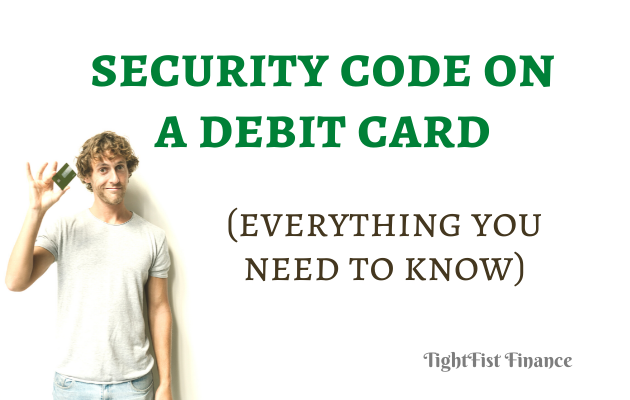What is the security code on my debit card?
The security code or (CVV) is a three or four digit code located on the back of your debit or credit card. A CVV is used to make online or over the phone purchases to ensure the actual card holder is indeed making the purchases.
In short, a security code keeps your information secured. You are less likely to have fraudulent charges because of three simple digits on your card.
Therefore, it’s important you fully understand what a CVV is and why you shouldn’t give it out to everyone. I’ll show you where to find your CVV and why your debit card might not have one. You’ll be on your way to making secure purchases in no time.

This article may contain affiliate links which pay a commission and support this blog. Thank you for your support!
What is the security code on a debit card?
CVV is an acronym which stands for card verification value and is often referred to as security code or card verification code (CVC). The CVV consists of three or four digits which are typically found on the back of your payment card. A security code helps protect the card holder from fraud by ensuring the card holder is making the payment.
Typically, you only use the security code for online transactions or when the physical card is not present.
Fraud is less likely to happen in person and you have to have the physical card to make a purchase. Anyone that is missing their debit card should have reported the card stolen or deactivated the card.
However, making a purchase when the card is not present is when most fraud occurs. Therefore, a would be identity theft would need your name, card expiration date, card number, and CVV to make a purchase.
For example, let’s assume you are out at a restaurant. You hand the waitress your card and she disappears to run the transaction. Your card is now out of your sight.
The waitress gets distracted and sets the card down behind the register. Someone with their iPhone could take a quick photo of the information on your card. They would now have access to your name, card expiration, and card number which are all located on the front of the card.
However, your CVV is located on the back of the card. This person did not get access to your CVV, so they can’t make any online purchases because they were not able to access the backside of your card.
Is CVV and security code the same?
CVV and security code mean the same thing for your debit or credit cards. The CVV is just an acronym which means card verification value which is a security feature (e.g. 3-digit security code) of your card.
You will be asked for a CVV or security code any time you make a purchase online or over the phone. Regardless, they mean the three or four digit code on the back of the card.
Does every debit card have CVV?
Every credit or debit card does have a CVV (e.g. security code) which is three or four digits on the back of the card. Prepaid debit or gift cards, such as Visa or American Express, will also have a CVV on the back of the card. Debit cards without a CVV are not approved for online transactions.
Where is the 3-digit security code on a debit card?
The three of four digit security code on the debit card is often found on the back of the card. There should be a dedicated space for your signature on the back of the card and the CVV is typically located to the right of it.
Summary: Security code on debit card
As you can see, the security code is the same thing as a CVV when it comes to debit and credit cards. A CVV is used to help protect you, the card holder, against fraud. The CVV is located on the back of the card, next to the signature line.
You will need a CVV for all purchases made online or over the phone. A CVV ensures the actual person with the card can be the only one making the purchase.
All debit and credit cards will have a CVV, unless you are not approved to make online transactions. Contact your card issuer if you wish to make online purchases.
